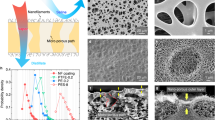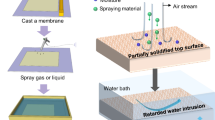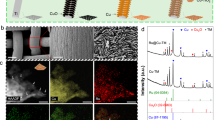Abstract
Surface heating membrane distillation overcomes several limitations inherent in conventional membrane distillation technology. Here we report a successful effort to grow in situ a hexagonal boron nitride (hBN) nanocoating on a stainless-steel wire cloth (hBN-SSWC), and its application as a scalable electrothermal heating material in surface heating membrane distillation. The novel hBN-SSWC provides superior vapour permeability, thermal conductivity, electrical insulation and anticorrosion properties, all of which are critical for the long-term surface heating membrane distillation performance, particularly with hypersaline solutions. By simply attaching hBN-SSWC to a commercial membrane and providing power with an a.c. supply at household frequency, we demonstrate that hBN-SSWC is able to support an ultrahigh power intensity (50 kW m−2) to desalinate hypersaline solutions with exceptionally high water flux (and throughput), single-pass water recovery and heat utilization efficiency while maintaining excellent material stability. We also demonstrate the exceptional performance of hBN-SSWC in a scalable and compact spiral-wound electrothermal membrane distillation module.
This is a preview of subscription content, access via your institution
Access options
Access Nature and 54 other Nature Portfolio journals
Get Nature+, our best-value online-access subscription
$29.99 / 30 days
cancel any time
Subscribe to this journal
Receive 12 print issues and online access
$259.00 per year
only $21.58 per issue
Buy this article
- Purchase on Springer Link
- Instant access to full article PDF
Prices may be subject to local taxes which are calculated during checkout





Similar content being viewed by others
Data availability
The datasets generated during and/or analysed during the current study are available from the corresponding author on reasonable request.
Code availability
The code utilized during the current study is available from the corresponding author on reasonable request.
Change history
04 November 2020
An amendment to this paper has been published and can be accessed via a link at the top of the paper.
References
Dongare, P. D. et al. Nanophotonics-enabled solar membrane distillation for off-grid water purification. Proc. Natl Acad. Sci. USA 114, 6936–6941 (2017).
Deshmukh, A. et al. Membrane distillation at the water-energy nexus: limits, opportunities, and challenges. Energy Environ. Sci. 11, 1177–1196 (2018).
Greenlee, L. F., Lawler, D. F., Freeman, B. D., Marrot, B. & Moulin, P. Reverse osmosis desalination: water sources, technology, and today’s challenges. Water Res. 43, 2317–2348 (2009).
Elimelech, M. & Phillip, W. A. The future of seawater desalination: energy, technology, and the environment. Science 333, 712–717 (2011).
Shaffer, D. L. et al. Desalination and reuse of high-salinity shale gas produced water: drivers, technologies, and future directions. Environ. Sci. Technol. 47, 9569–9583 (2013).
Lawson, K. W. & Lloyd, D. R. Membrane distillation. J. Membr. Sci. 124, 1–25 (1997).
Tow, E. W. et al. Comparison of fouling propensity between reverse osmosis, forward osmosis, and membrane distillation. J. Membr. Sci. 556, 352–364 (2018).
Dudchenko, A. V., Chen, C., Cardenas, A., Rolf, J. & Jassby, D. Frequency-dependent stability of CNT Joule heaters in ionizable media and desalination processes. Nat. Nanotechnol. 12, 557–563 (2017).
Tan, Y. Z., Chandrakant, S. P., Ang, J. S. T., Wang, H. & Chew, J. W. Localized induction heating of metallic spacers for energy-efficient membrane distillation. J. Membr. Sci. 606, 118150 (2020).
Boo, C. & Elimelech, M. Thermal desalination membranes: carbon nanotubes keep up the heat. Nat. Nanotechnol. 12, 500–503 (2017).
Song, L. et al. Large scale growth and characterization of atomic hexagonal boron nitride layers. Nano Lett. 10, 3209–3215 (2010).
Dean, C. R. et al. Boron nitride substrates for high-quality graphene electronics. Nat. Nanotechnol. 5, 722–725 (2010).
Falin, A. et al. Mechanical properties of atomically thin boron nitride and the role of interlayer interactions. Nat. Commun. 8, 15815 (2017).
Watanabe, K., Taniguchi, T. & Kanda, H. Direct-bandgap properties and evidence for ultraviolet lasing of hexagonal boron nitride single crystal. Nat. Mater. 3, 404–409 (2004).
Jiang, P., Qian, X., Yang, R. & Lindsay, L. Anisotropic thermal transport in bulk hexagonal boron nitride. Phys. Rev. Mater. 2, 064005 (2018).
Chilkoor, G. et al. Hexagonal boron nitride: the thinnest insulating barrier to microbial corrosion. ACS Nano 12, 2242–2252 (2018).
Zhang, J., Yang, Y. C. & Lou, J. Investigation of hexagonal boron nitride as an atomically thin corrosion passivation coating in aqueous solution. Nanotechnology 27, 364004 (2016).
Hu, S. et al. Proton transport through one-atom-thick crystals. Nature 516, 227–230 (2014).
Liu, Z. et al. Ultrathin high-temperature oxidation-resistant coatings of hexagonal boron nitride. Nat. Commun. 4, 2541 (2013).
Costescu, R., Cahill, D., Fabreguette, F., Sechrist, Z. & George, S. Ultra-low thermal conductivity in W/Al2O3 nanolaminates. Science 303, 989–990 (2004).
Abdulagatov, A. et al. Al2O3 and TiO2 atomic layer deposition on copper for water corrosion resistance. ACS Appl. Mater. Interfaces 3, 4593–4601 (2011).
Liu, Z. et al. In-plane heterostructures of graphene and hexagonal boron nitride with controlled domain sizes. Nat. Nanotechnol. 8, 119–124 (2013).
Pakdel, A., Zhi, C., Bando, Y. & Golberg, D. Low-dimensional boron nitride nanomaterials. Materials Today 15, 256–265 (2012).
Sun, J. et al. Recent progress in the tailored growth of two-dimensional hexagonal boron nitride via chemical vapour deposition. Chem. Soc. Rev. 47, 4242–4257 (2018).
Lu, G. et al. Synthesis of large single-crystal hexagonal boron nitride grains on Cu–Ni alloy. Nat. Commun. 6, 6160 (2015).
Lu, G. et al. Synthesis of high-quality graphene and hexagonal boron nitride monolayer in-plane heterostructure on Cu–Ni alloy. Adv. Sci. 4, 1700076 (2017).
Zhang, Z., Liu, Y., Yang, Y. & Yakobson, B. I. Growth mechanism and morphology of hexagonal boron nitride. Nano Lett. 16, 1398–1403 (2016).
Chen, T.-C., Ho, C.-D. & Yeh, H.-M. Theoretical modeling and experimental analysis of direct contact membrane distillation. J. Membr. Sci. 330, 279–287 (2009).
Lin, S., Yip, N. Y. & Elimelech, M. Direct contact membrane distillation with heat recovery: thermodynamic insights from module scale modeling. J. Membr. Sci. 453, 498–515 (2014).
Naidu, G., Jeong, S., Choi, Y. & Vigneswaran, S. Membrane distillation for wastewater reverse osmosis concentrate treatment with water reuse potential. J. Membr. Sci. 524, 565–575 (2017).
Luo, W. H. et al. An osmotic membrane bioreactor–membrane distillation system for simultaneous wastewater reuse and seawater desalination: performance and implications. Environ. Sci. Technol. 51, 14311–14320 (2017).
Efome, J. E., Rana, D., Matsuura, T. & Lan, C. Q. Enhanced performance of PVDF nanocomposite membrane by nanofiber coating: a membrane for sustainable desalination through MD. Water Res. 89, 39–49 (2016).
Mericq, J. P., Laborie, S. & Cabassud, C. Vacuum membrane distillation of seawater reverse osmosis brines. Water Res. 44, 5260–5273 (2010).
Zhang, Y., Peng, Y., Ji, S., Li, Z. & Chen, P. Review of thermal efficiency and heat recycling in membrane distillation processes. Desalination 367, 223–239 (2015).
Leitch, M. E., Li, C., Ikkala, O., Mauter, M. S. & Lowry, G. V. Bacterial nanocellulose aerogel membranes: novel high-porosity materials for membrane distillation. Environ. Sci. Technol. Lett. 3, 85–91 (2016).
Deshmukh, A. & Elimelech, M. Understanding the impact of membrane properties and transport phenomena on the energetic performance of membrane distillation desalination. J. Membr. Sci. 539, 458–474 (2017).
Alsaadi, A. S. et al. Modeling of air-gap membrane distillation process: a theoretical and experimental study. J. Membr. Sci. 445, 53–65 (2013).
Al-Obaidani, S. et al. Potential of membrane distillation in seawater desalination: thermal efficiency, sensitivity study and cost estimation. J. Membr. Sci. 323, 85–98 (2008).
Tran, T. T., Bray, K., Ford, M. J., Toth, M. & Aharonovich, I. Quantum emission from hexagonal boron nitride monolayers. Nat. Nanotechnol. 11, 37–41 (2016).
Hattori, Y., Taniguchi, T., Watanabe, K. & Nagashio, K. Layer-by-layer dielectric breakdown of hexagonal boron nitride. ACS Nano 9, 916–921 (2015).
Acknowledgements
This work was supported by the NSF Nanosystems Engineering Research Center for Nanotechnology-Enabled Water Treatment (EEC-1449500) and the NSF I/UCRC Center for Atomically Thin Multifunctional Coatings (ATOMIC) under award number IIP-1539999.
Author information
Authors and Affiliations
Contributions
K.Z. and W.W. contributed equally to this work; they designed and performed the experiments, analysed the data and wrote the manuscript. J.L, Q.L., P.M.A. and M.E. conceived the idea, revised the manuscript and led the project. S.J., H.G., R.X. and A.D. assisted with the sample growth, TEM characterization, MD operation and simulation, respectively.
Corresponding authors
Ethics declarations
Competing interests
The authors declare no competing interests.
Additional information
Peer review information Nature Nanotechnology thanks Shihong Lin and the other, anonymous, reviewer(s) for their contribution to the peer review of this work.
Publisher’s note Springer Nature remains neutral with regard to jurisdictional claims in published maps and institutional affiliations.
Supplementary information
Supplementary Information
Supplementary Tables 1–6, Figs. 1–16 and refs. 1–53.
Rights and permissions
About this article
Cite this article
Zuo, K., Wang, W., Deshmukh, A. et al. Multifunctional nanocoated membranes for high-rate electrothermal desalination of hypersaline waters. Nat. Nanotechnol. 15, 1025–1032 (2020). https://doi.org/10.1038/s41565-020-00777-0
Received:
Accepted:
Published:
Issue Date:
DOI: https://doi.org/10.1038/s41565-020-00777-0
This article is cited by
-
Structure integration and architecture of solar-driven interfacial desalination from miniaturization designs to industrial applications
Nature Water (2024)
-
Shielding effect enables fast ion transfer through nanoporous membrane for highly energy-efficient electrodialysis
Nature Water (2023)
-
A review of membrane distillation enhancement via thermal management and molecular transport through nanomaterial-based membranes
Science China Technological Sciences (2023)
-
Mitigation of Thermal Energy in Membrane Distillation for Environmental Sustainability
Current Pollution Reports (2023)
-
From plasma to plasmonics: toward sustainable and clean water production through membranes
Frontiers of Chemical Science and Engineering (2023)



